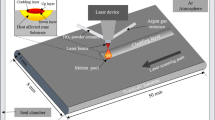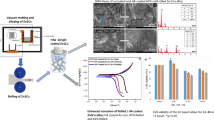Abstract
It is known that the "race for the surface" determining the in vivo response is strictly connected to the physico-chemical properties of the material, especially at its surface. Accordingly, the study of surface roughness, charge and wettability is fundamental to predict the bio-response to the implant. In this work, streaming potential was chosen as a reliable method to quantify the solid surface charge of hydrothermally treated (HT) TiO2-anatase nano-crystalline coatings, grown on titanium substrates. The influence of metal and ionic conductance on the zeta potential values was taken into account, allowing for the correlation of the surface charge with the coating porosity, the semiconductor character of the TiO2 nano-crystals and the metallic nature of the bulk titanium.
Graphical Abstract



Similar content being viewed by others
References
Gristina AG. Biomaterial-centered infection: microbial adhesion versus tissue integration. Science. 1987;237(4822):1588–95.
Werner C, König U, Augsburg A, Arnhold C, Körber H, Zimmermann R, et al. Electrokinetic surface characterization of biomedical polymers—a survey. Colloids Surf. 1999;159(2–3):519–29. doi:10.1016/S0927-7757(99)00290-3.
Lorenzetti M, Bernardini G, Luxbacher T, Santucci A, Kobe S, Novak S. Surface properties of nanocrystalline TiO2 coatings in relation to the in vitro plasma protein adsorption. Biomed Mater. 2014 (submitted).
Yaroshchuk A, Luxbacher T. Interpretation of electrokinetic measurements with porous films: role of electric conductance and streaming current within porous structure. Langmuir. 2010;26(13):10882–9. doi:10.1021/la100777z.
Yaroshchuk A, Ribitsch V. Role of channel wall conductance in the determination of ζ-potential from electrokinetic measurements. Langmuir. 2002;18(6):2036–8. doi:10.1021/la015557m.
Marucco A, Fenoglio I, Turci F, Fubini B. Interaction of fibrinogen and albumin with titanium dioxide nanoparticles of different crystalline phases. J Phys. 2013;429(1):012014.
Norde W, Lyklema J. The adsorption of human plasma albumin and bovine pancreas ribonuclease at negatively charged polystyrene surfaces: IV. The charge distribution in the adsorbed state. J Colloid Interface Sci. 1978;66(2):285–94. doi:10.1016/0021-9797(78)90306-5.
Makino K, Ohshima H, Kondo T. Interaction of poly(l-lactide) microcapsule surface with plasma proteins: reversal of zeta potential caused by fibrinogen. J Colloid Interface Sci. 1987;115(1):65–72. doi:10.1016/0021-9797(87)90009-9.
Roach P, Farrar D, Perry CC. Interpretation of protein adsorption: surface-induced conformational changes. J Am Chem Soc. 2005;127(22):8168–73. doi:10.1021/ja042898o.
Acknowledgments
This work was supported by the European Commission within the framework of the FP7-ITN network BioTiNet (grant No. FP7-PEOPLE-2010-ITN-264635). Authors thank Ms. Sandra Zierler and Ms. Renate Kohl for their help with the zeta potential measurements.
Author information
Authors and Affiliations
Corresponding authors
Rights and permissions
About this article
Cite this article
Lorenzetti, M., Luxbacher, T., Kobe, S. et al. Electrokinetic behaviour of porous TiO2-coated implants. J Mater Sci: Mater Med 26, 191 (2015). https://doi.org/10.1007/s10856-015-5521-4
Received:
Accepted:
Published:
DOI: https://doi.org/10.1007/s10856-015-5521-4




